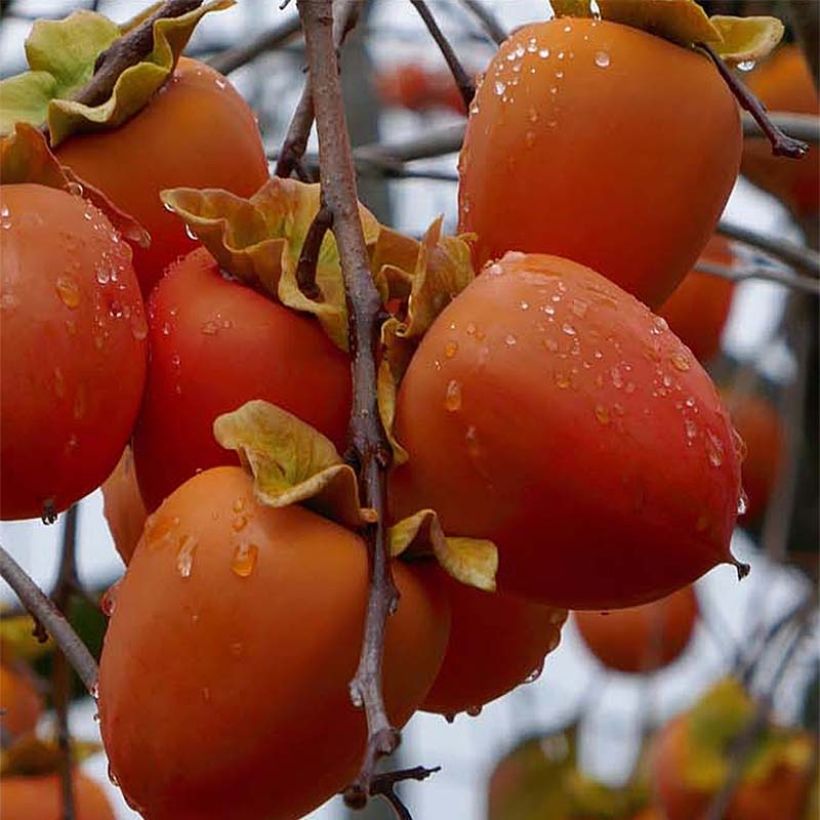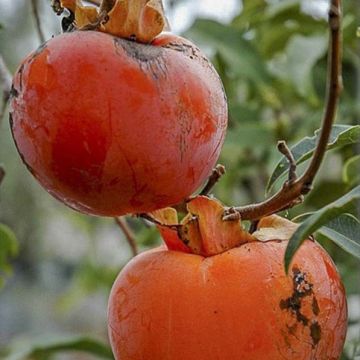

Diospyros kaki Sharon - Persimmon
Diospyros kaki Sharon - Persimmon
Diospyros kaki Sharon
Persimmon, Kaki, Japanese Persimmon, Oriental Persimmon
Je lai recu en racine nues , L'arbre est magnifique ! plus quand attendrequ'il pousse
Gildas, 01/01/2023
Special offer!
Receive a €20 voucher for any order over €90 (excluding delivery costs, credit notes, and plastic-free options)!
1- Add your favorite plants to your cart.
2- Once you have reached €90, confirm your order (you can even choose the delivery date!).
3- As soon as your order is shipped, you will receive an email containing your voucher code, valid for 3 months (90 days).
Your voucher is unique and can only be used once, for any order with a minimum value of €20, excluding delivery costs.
Can be combined with other current offers, non-divisible and non-refundable.
Why not try an alternative variety in stock?
View all →This plant carries a 6 months recovery warranty
More information
We guarantee the quality of our plants for a full growing cycle, and will replace at our expense any plant that fails to recover under normal climatic and planting conditions.
Description
Diospyros kaki 'Sharon' (also known as 'Triumph' and 'Sharoni') is a variety of persimmon tree cultivated on a large scale, with its fruits found on many stalls in autumn and winter. When ripe, its flattened persimmons are orange in colour and have a characteristic ribbed and slightly square shape. They are appreciated for their soft and very sweet flesh, which has few seeds. This fairly vigorous tree is highly productive and provides a regular harvest from year to year. The persimmons are harvested from late October to early November.
'Sharon' belongs to the category of astringent persimmon trees, meaning they are only edible when over-ripe with a soft texture. This happens after being exposed to a light frost. This variety produces medium-sized fruits with thin skin and a fairly fine pulp. The tasty flesh is very sweet when fully over-ripe. The fruits can be cooked into jam or compote, eaten raw in salads with or without cream, or dried in the same way as figs. Explore all the different ways to discover their various flavours.
Diospyros kaki belongs to the Ebenaceae family, like ebony (D. ebenum), with which it shares a common feature: very hard wood. Its name comes from the combination of the Greek words "Dios" (God) and "Pyros" (wheat). It originates from the Far East, particularly from southern China.
It develops a rounded habit, reaching a height of 6 to 10m (20 to 33ft) and a width of 5 to 7m (16 to 23ft). Its growth rate is rather slow. The shiny green leaves are elongated, measuring about 15cm (6in) long.
'Sharon' is hardy to -15°C (5°F), although occasional severe frosts in eastern regions can weaken it. It is a self-fertile variety. The flowering is late, appearing in May-June, in the form of small insignificant yellow flowers that are pollinated by insects.
Report an error about the product description
Diospyros kaki Sharon - Persimmon in pictures




Plant habit
Fruit
Flowering
Foliage
Botanical data
Diospyros
kaki
Sharon
Ebenaceae
Persimmon, Kaki, Japanese Persimmon, Oriental Persimmon
Cultivar or hybrid
Diospyros lotus (7.5L/10L pot - Half standard)
Planting and care
Plant in autumn-winter, outside the freezing period, or alternatively in spring, with regular watering. Choose a sheltered and sunny location. It thrives in all types of soil, preferably with an acidic tendency (it fears excess limestone). It thrives in well-drained and rich soils, and tolerates water shortage fairly well in summer, especially in deep soil. Space them 5 to 7m (16 to 23ft) apart in all directions.
Soak the root ball in water for a few moments before planting. Dig a hole 3 to 4 times the volume of the root ball, making sure to separate the bottom soil from the top soil. Mix the bottom soil with crushed horn and well-rotted compost or potting soil, then pour this mixture into the planting hole. Install a stake. Place the root ball, without burying the collar, cover with the top soil and firm it down. Form a basin around the base and water generously. Attach the stake to the plant, crossing the tie in the shape of an 8, without touching the trunk. Water regularly in the first year and then as needed, mainly in case of high temperatures.
Apply well-rotted compost every year in spring by raking it into the surface, taking care not to damage the roots.
It is less susceptible to diseases and pests.
Planting period
Intended location
Care
-
, onOrder confirmed
Reply from on Promesse de fleurs
Haven't found what you were looking for?
Hardiness is the lowest winter temperature a plant can endure without suffering serious damage or even dying. However, hardiness is affected by location (a sheltered area, such as a patio), protection (winter cover) and soil type (hardiness is improved by well-drained soil).

Photo Sharing Terms & Conditions
In order to encourage gardeners to interact and share their experiences, Promesse de fleurs offers various media enabling content to be uploaded onto its Site - in particular via the ‘Photo sharing’ module.
The User agrees to refrain from:
- Posting any content that is illegal, prejudicial, insulting, racist, inciteful to hatred, revisionist, contrary to public decency, that infringes on privacy or on the privacy rights of third parties, in particular the publicity rights of persons and goods, intellectual property rights, or the right to privacy.
- Submitting content on behalf of a third party;
- Impersonate the identity of a third party and/or publish any personal information about a third party;
In general, the User undertakes to refrain from any unethical behaviour.
All Content (in particular text, comments, files, images, photos, videos, creative works, etc.), which may be subject to property or intellectual property rights, image or other private rights, shall remain the property of the User, subject to the limited rights granted by the terms of the licence granted by Promesse de fleurs as stated below. Users are at liberty to publish or not to publish such Content on the Site, notably via the ‘Photo Sharing’ facility, and accept that this Content shall be made public and freely accessible, notably on the Internet.
Users further acknowledge, undertake to have ,and guarantee that they hold all necessary rights and permissions to publish such material on the Site, in particular with regard to the legislation in force pertaining to any privacy, property, intellectual property, image, or contractual rights, or rights of any other nature. By publishing such Content on the Site, Users acknowledge accepting full liability as publishers of the Content within the meaning of the law, and grant Promesse de fleurs, free of charge, an inclusive, worldwide licence for the said Content for the entire duration of its publication, including all reproduction, representation, up/downloading, displaying, performing, transmission, and storage rights.
Users also grant permission for their name to be linked to the Content and accept that this link may not always be made available.
By engaging in posting material, Users consent to their Content becoming automatically accessible on the Internet, in particular on other sites and/or blogs and/or web pages of the Promesse de fleurs site, including in particular social pages and the Promesse de fleurs catalogue.
Users may secure the removal of entrusted content free of charge by issuing a simple request via our contact form.
The flowering period indicated on our website applies to countries and regions located in USDA zone 8 (France, the United Kingdom, Ireland, the Netherlands, etc.)
It will vary according to where you live:
- In zones 9 to 10 (Italy, Spain, Greece, etc.), flowering will occur about 2 to 4 weeks earlier.
- In zones 6 to 7 (Germany, Poland, Slovenia, and lower mountainous regions), flowering will be delayed by 2 to 3 weeks.
- In zone 5 (Central Europe, Scandinavia), blooming will be delayed by 3 to 5 weeks.
In temperate climates, pruning of spring-flowering shrubs (forsythia, spireas, etc.) should be done just after flowering.
Pruning of summer-flowering shrubs (Indian Lilac, Perovskia, etc.) can be done in winter or spring.
In cold regions as well as with frost-sensitive plants, avoid pruning too early when severe frosts may still occur.
The planting period indicated on our website applies to countries and regions located in USDA zone 8 (France, United Kingdom, Ireland, Netherlands).
It will vary according to where you live:
- In Mediterranean zones (Marseille, Madrid, Milan, etc.), autumn and winter are the best planting periods.
- In continental zones (Strasbourg, Munich, Vienna, etc.), delay planting by 2 to 3 weeks in spring and bring it forward by 2 to 4 weeks in autumn.
- In mountainous regions (the Alps, Pyrenees, Carpathians, etc.), it is best to plant in late spring (May-June) or late summer (August-September).
The harvesting period indicated on our website applies to countries and regions in USDA zone 8 (France, England, Ireland, the Netherlands).
In colder areas (Scandinavia, Poland, Austria...) fruit and vegetable harvests are likely to be delayed by 3-4 weeks.
In warmer areas (Italy, Spain, Greece, etc.), harvesting will probably take place earlier, depending on weather conditions.
The sowing periods indicated on our website apply to countries and regions within USDA Zone 8 (France, UK, Ireland, Netherlands).
In colder areas (Scandinavia, Poland, Austria...), delay any outdoor sowing by 3-4 weeks, or sow under glass.
In warmer climes (Italy, Spain, Greece, etc.), bring outdoor sowing forward by a few weeks.




































